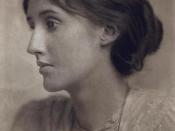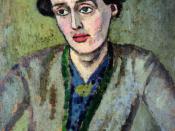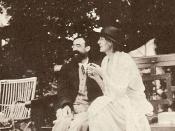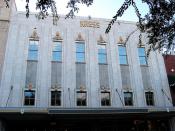Cabamongan 1 Lanie Cabamongan Professor Snider World Literature 100 13 November 2002 Societal Gender Roles In her fantasy biographical novel, Orlando, Virginia Woolf examines the role of men and women in English society through the main character, Orlando. Throughout the story, she highlights the disparities between the two sexes and pokes fun at the absurd ways that women and men react to each other. As the story progresses, Orlando, an Elizabethan nobleman who is mystically changed to a woman, matures and is enlightened by the experience of being two sexes. She realizes that men and women are more similar in nature than each would like to think; they both yearn for love, search for the meaning of life, and have ambitions. However, society imposes rules and stereotypes of feminism and masculinity and demands that they are categorized differently.
The overwhelming theme of Orlando is the differences between genders and the factors that determine it.
The story seeks to find the answer of whether men and women are truly different and the reasons behind it. When Orlando wakes up to find herself suddenly transformed to a woman, she reacts calmly and nonchalantly takes a bath as if waking up to a regular day. She is not at all affected by the change of her gender because she doesn't feel any difference at all. She still feels and thinks the same and her view on life and love remain unchanged. Only when she embarks on an English ship to return home that she begins to realize the difference. For the first time, she dresses as a woman and wears a skirt. Her outfit and the way people act towards her seem to make her feel and act different. That scene seem to reinforce the story's theme that gender roles are created by society, not given to humans naturally.
Another theme in Orlando is conforming to society. Through the 400 hundred years that she lives, new situations are constantly thrown at her. She conforms to these changes and adjusts herself to fit in. When Orlando is sent to Turkey, she learns the language and tries to adapt to the culture. After running to the gypsy community to seek refuge from the riots in the city, she also tries to change to fit in. In the nineteenth century when most of the women of noble birth were getting married and having children, she too finds herself a husband and ultimately has a baby. She conforms to the changing times and new situations because she knows it's the only way to survive among people and be accepted in society. However, these conformities repress Orlando. She eventually gets tired of adjusting herself to the changes of time and society. In the very end, she resists change and conformity and chooses to be whoever she wants to be and feels liberated by it.
Orlando's love for writing poetry is the only thing that remains constant in the whole story. Her passion for writing remains the same even when she becomes Ambassador, a refuge in the gypsy community, and a Lady in the English court. When Orlando is transformed into a woman, her passion for writing and finishing "The Oak Tree" doesn't wane at all. This form of artistic creativity is significant in Orlando's life. Orlando portrays Jungian's archetype of the artist who simply can't help expressing herself artistically through poetry. Poetry is one of Orlando's greatest loves and it is what links her and all her former selves together.
Clothing holds an important motif in Orlando. There are several incidents of cross-dressing in the story. The Archduke Harry dresses as a woman to get near to Orlando whom he has fallen in love with. He later reveals his true gender when Orlando returns home as a woman. Similarly, Orlando cross-dresses as a man frequently after she becomes a woman. Despite the different clothes that Orlando wears, she is the same inside. She only cross-dresses only when she wants to engage in activities that society only permits male to do, such as walking in the city by herself. Virginia Woolf uses the clothing motif to reveal to her readers the similarities between men and women. She's trying to get the point across that society is too strict about the roles that men and women are forced to play out. Men and women are similar inside and each sex should have the freedom to act how they please beyond what society permits.
Virginia Woolf writes Orlando in a third person point of view Orlando gives invaluable insights on how Virginia Woolf felt toward the patriarchcal society she lived in. She felt oppressed as a woman living in the Victorian age and voiced out her anger through her literary works. Her feministic tendencies are evident in Orlando. Upon realizing how inferior the male sex treated the female sex she cried out to herself, "to deny a woman teaching lest she may praise you; to be the slave of the frailest chit in petticoats, and to go about as if you were the Lords of creation. (Woolf 158)"





